I will fully understand if nobody believes me, but I am doing my level best not to turn things into a Weird Pen Wednesday. Really, I am. I already have one of those to maintain and I need to do another like I need a hole in my pocket.
But somehow, I couldn’t resist this.
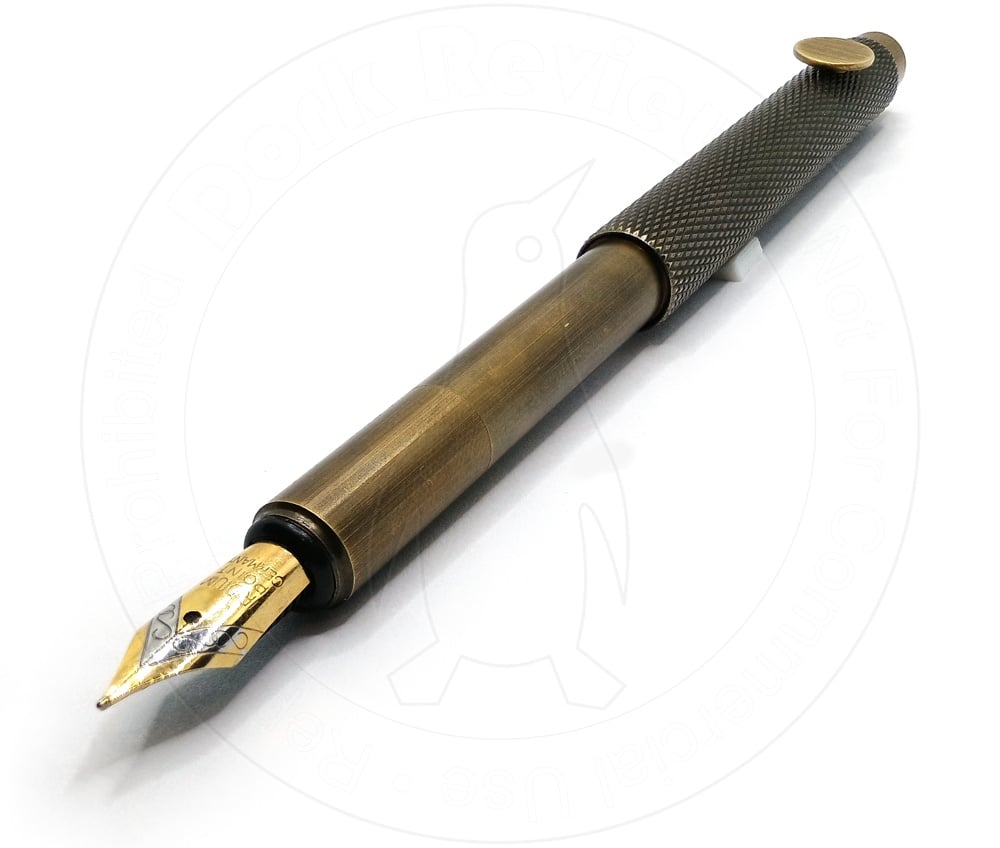
I don’t have a name or a model designation for it, but these are relatively easy to find from your favorite distributor of knockoff Chinese white box goods. This one was labeled “Brass Fountain Pen Kawaii Ink Pen EF/F/Bent Nib Excellent Business Office School Supplies Pens.”
It’s called a lot of other things elsewhere, in the typical word-salad way of this type of nonsense, usually involving terms like “retro,” “vintage,” and quite frequently, “kawaii.” Yes, truly its design is very human.
But regardless of all of this, in my cursory research I couldn’t nail down any original manufacturer by name. Or a model number. Or much of anything else, really.
You can pay any amount of money for one of these since they seem to be listed all over hell and creation with no difference between them other than the chutzpah of whoever’s selling it. “EYPKPL,” for instance, have the audacity to list this for as much as $36 at the time of writing which is quite absurd. Meanwhile “SHIONEOFI” present a more reasonable $12. If you’re hipper still you can pay around $6, and be further assured that “This merchant is committed to only offering products that comply with the General Product Safety Regulation.”
And if you really want to throw caution to the wind you can score one for as little as $1.78. You may be old and wizened by the time it shows up, though.
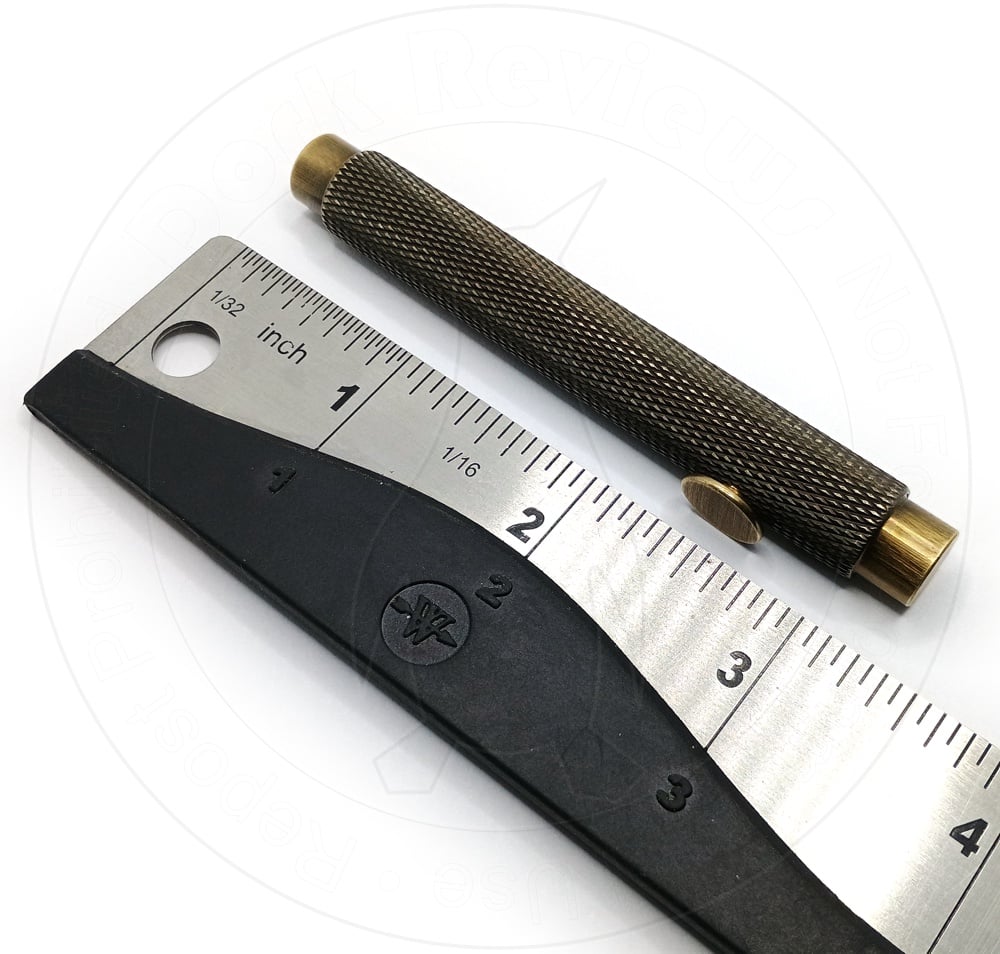
I have, as usual, buried the lede a bit.
The “Kawaii,” you see, packs up to be very small. By my measure it is 84.3mm when fully stowed, or just a hair under 3-3/8". When deployed it’s precisely 150mm long, or at least my example is. I’ll bet you there’s a little bit of variation from one piece to another, which we’ll get to in a bit.
So it’s not just another potentially awful anonymous Chinese pen. It’s one of those that’s really, really small. So that’s something.
It is also very, thoroughly, extremely crosshatched on the outside. There is a very pronounced pattern texturing the entirety of the outer barrel completely from stem to stern. Somebody somewhere has a half nut drive on their lathe and they’re very proud to show it off.
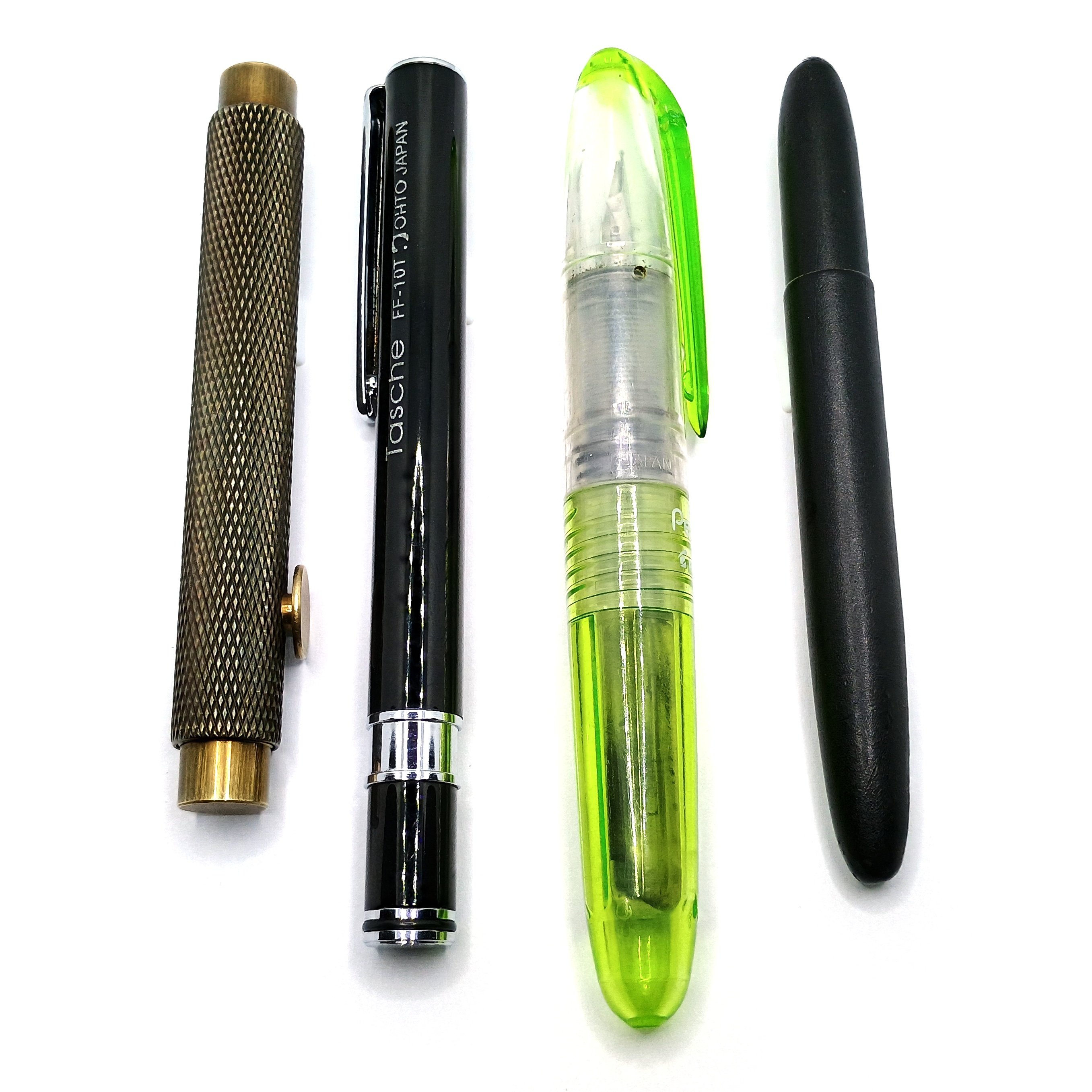
For grinsies, here is a quick comparison with a variety of shorties of an ostensibly similar vein. From left to right is our subject, then an Ohto Tasche, a much beleaguered Pilot Petit, and the obligatory Fisher Bullet that just appears whenever one of these comparisons comes up whether you wanted it to or not. It is damn strange how that always happens, come to think of it.
The Kawaii Desu Elegant Retro Vintage Stationery Excellent Ink Writing Pen High End Elegant is shorter than all of them.
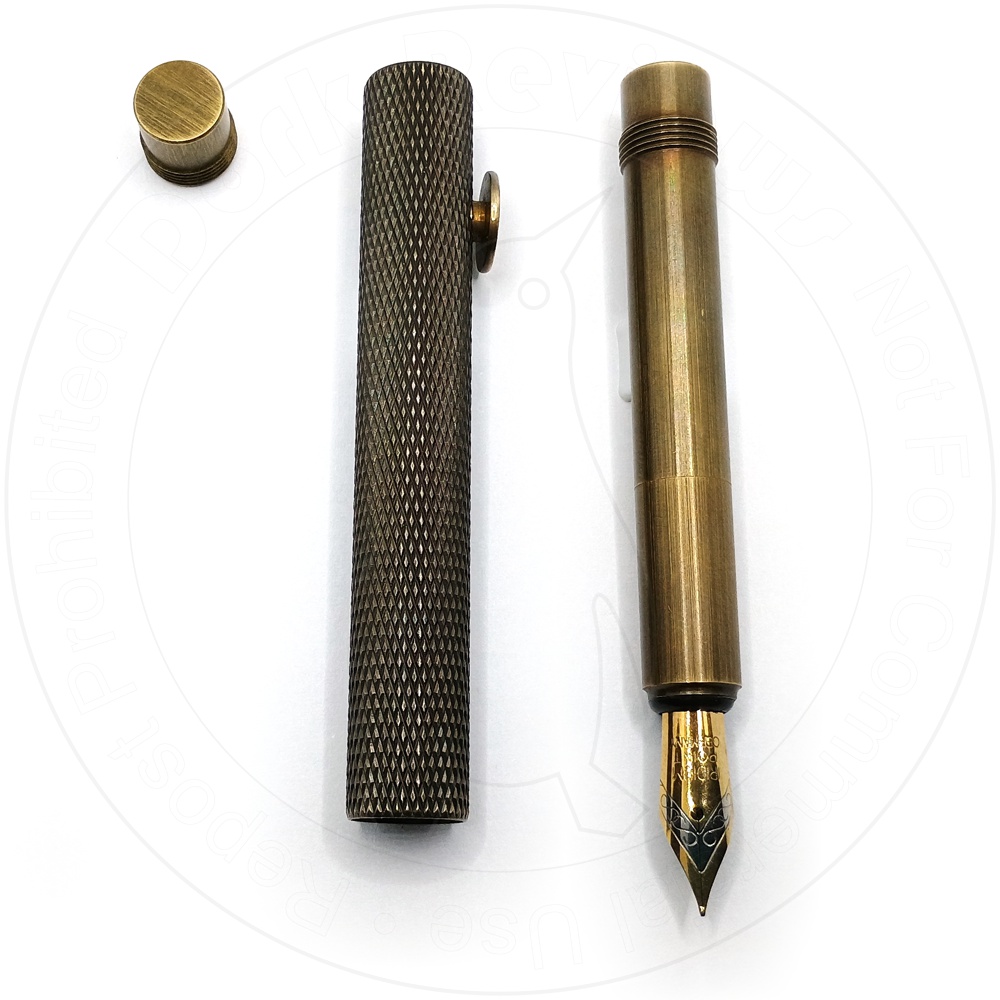
This isn’t a slider mechanism, a clicker, or even a twister. To get it writing ready, you unscrew the front half of the pen which stows inside the other half of the body, flip it around, and screw it back in where it came from a bit like assembling a pool cue. (You could also eschew this entirely if you really wanted to and just write with the stub of the front half, which is naturally fully functional all by itself.)
It’s thus got two diameter measurements. The outer body which becomes the tail is 11.02mm not including its protruding buttony thing, again more on which later. The inner body which then becomes the grip section is a pleasingly slim 9.03mm. Altogether it weighs 26.4 grams – or 0.93 ounces in the old money.
This is because its body is entirely brass. And it genuinely is brass, not “brass” as we’ve occasionally seen before, where some turkey applied a brassy finish coating over something else and lied about it. I can happily report that a magnet does not stick to it, so it certainly isn’t steel. Okay, so it might be zinc or some other potmetal. But it looks like brass, feels like brass, and with some initial trepidation I can tell you it tastes like brass, too. So it probably is.
Oh, yes. And the plug that isn’t the writing end also unscrews and looks identical before you remove it. So you’d better remember which end is which. The two ends are totally interchangeable so you can screw either end into the body as you see fit.
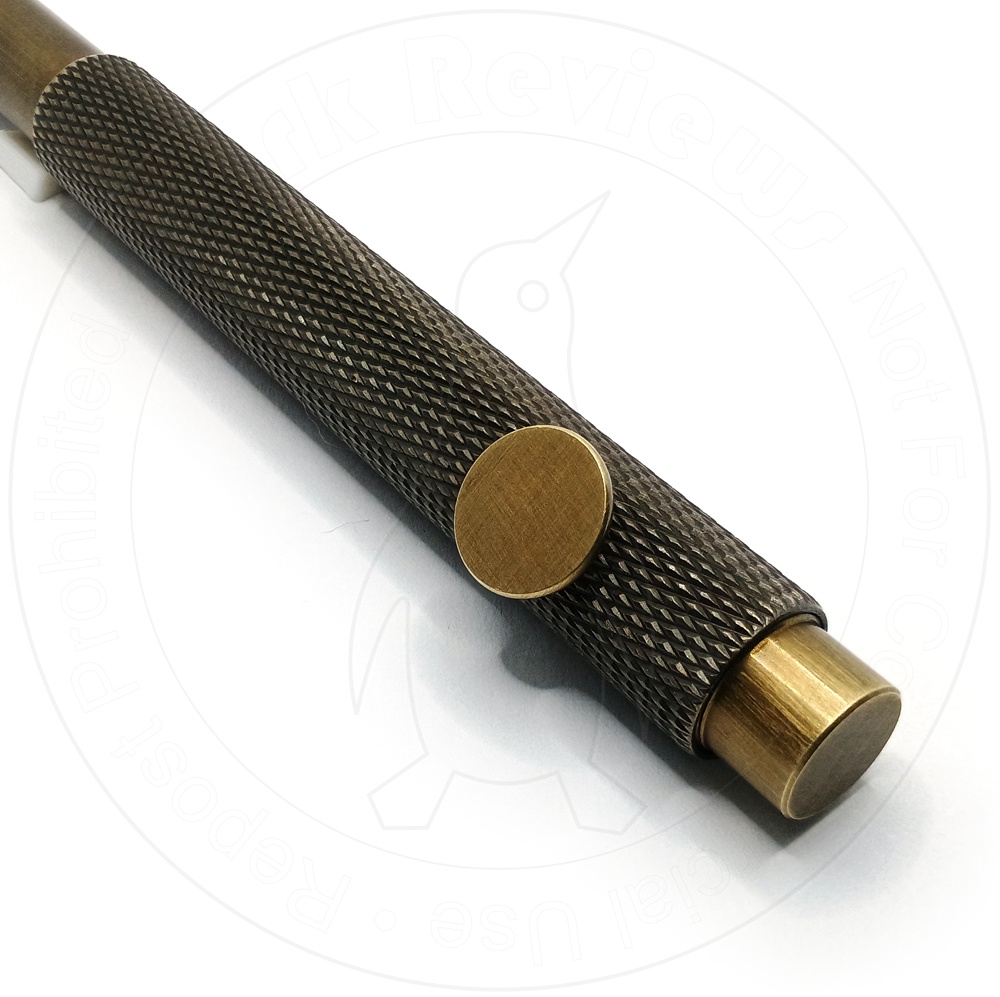
There isn’t a clip, but in its place is this brass button thing. It is theoretically removable in that you can plainly see it’s threaded and screwed into the pen body if you look at it from the inside. But it’s threadlockered or glued somehow, and undoing it would surely require grabbing it with pliers which would mar the finish. So I left mine where it was. For now, anyway.
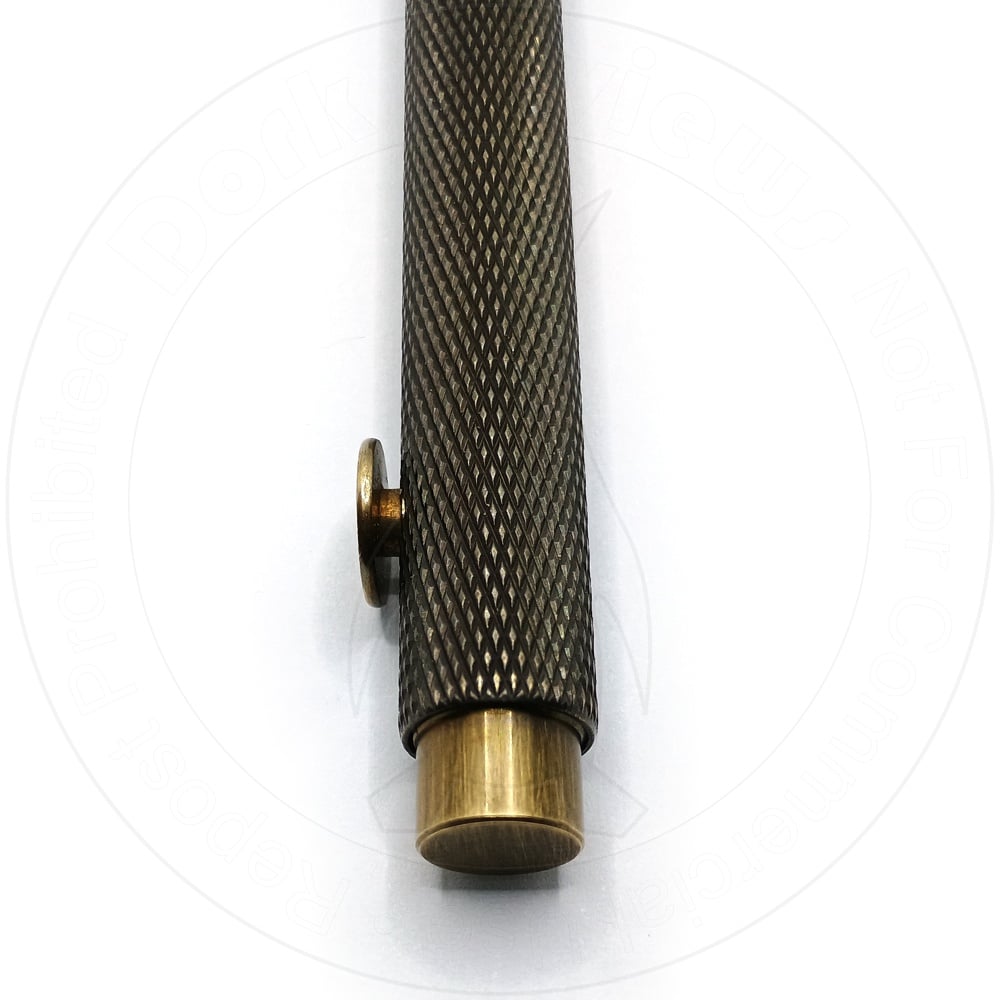
The button does serve to keep the pen from rolling away but it doesn’t do anything else. You can’t press it and it doesn’t move in any way, so it’s no good as a fiddle aid. There is a gap between it and the pen body but the disk that comprises it really isn’t enough to allow it to serve as an effective clip. I think it would have been better if it were a clip, honestly, and as it stands now there’s really no elegant way to carry this thing. It’s just begging to have its endcap drilled out and a keyring or similar installed in it. Or something – anything. But be careful with that, because the point does rest inside the tailcap some ways when the pen is in its stowed configuration, and the cap is hollow.
Maybe someone suitably motivated could muscle the button out to determine what thread it has (surely it’s a standard M3 or M4 pitch given that the factory must have been too cheap to develop anything bespoke) and replace it with something else.
Oh well, I guess for two bucks you could afford to experiment. I’m going to get all my photography done before I go around breaking mine, though.
Bits and Pieces

The grip section of the pen further unscrews roughly in the middle of itself, and that’s where the cartridge gets installed.
Actually, let’s talk about the cartridge because there’s more weirdness afoot, here. And while we’re at it we’ll sidetrack ourselves into a lot of other things, too, because that’s how we roll.
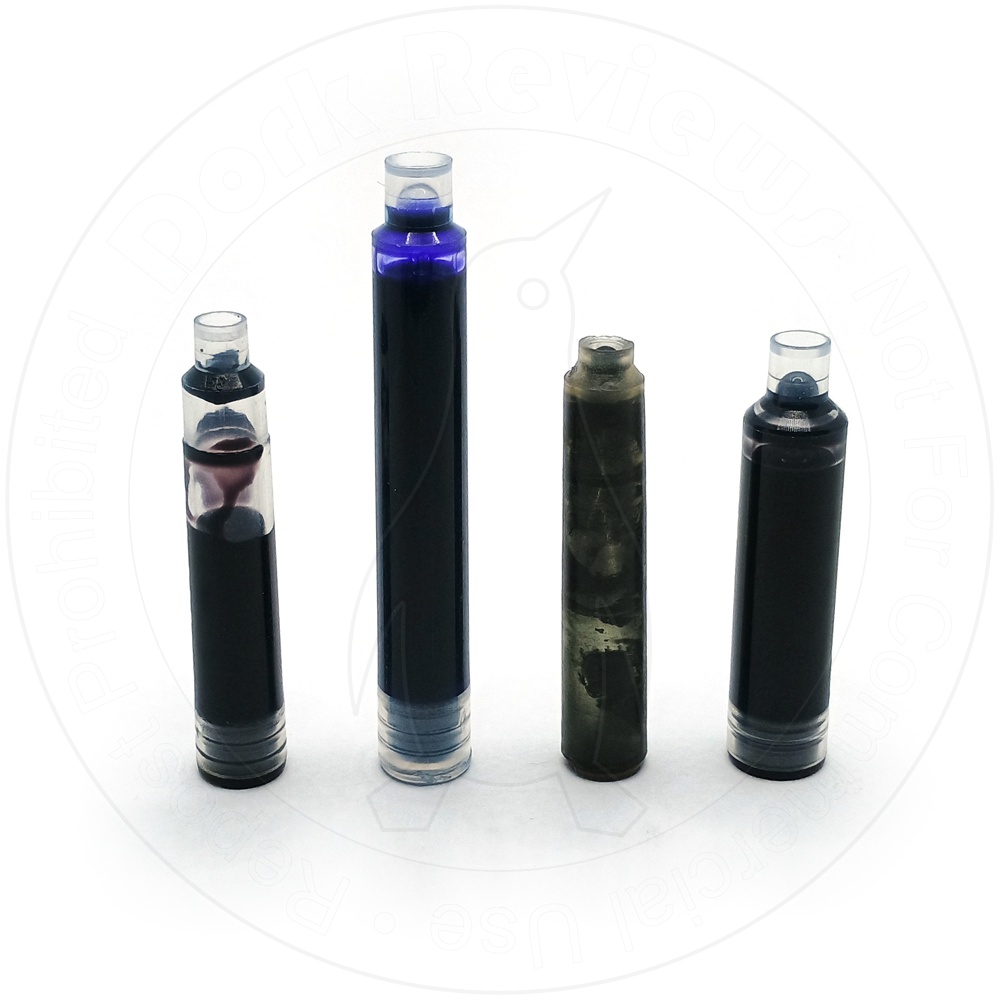
My Kawaii Desu didn’t come in any kind of packaging at all, really. Just a clear plastic baggie; no box, no card. That means it also came with no documentation. Not even a cursory “QC Pass” sticker. Luckily it did come with a cartridge, because otherwise it has nothing whatsoever to describe what kind of cartridge it takes.
The majority of nameless Chinese pens these days all take similar cartridges to each other, which have a 3.4mm inner neck diameter and are about 50mm long. I can’t find any official name for these things but they’re the closest you can get a Chinese standard if you can consider such a thing without bursting out laughing.
Well, this pen doesn’t take those. Its cartridge is on the far left, above. There’s a Chinese Standard (snerk) right next to it, in this case one of the ones that came with my Oaso. It’s most similar to the standard international short cartridge, which is the next one in line. And it certainly isn’t whatever tomfoolery came with my Writech. We have another mystery on our hands.
I measured the inner neck diameter at 2.6mm, and the cartridge is 39.15mm in overall length. We’ll call it 39. So that’s very close to the international short, but not quite.
This is apparently a size that exists, though, but I’ve never handled one in detail before so I don’t know what it’s called, either. If it’s even called anything. You can buy spares e.g. here, so this appears to be perhaps yet another chimera dreamed up by the Chinese.
I tried and you can indeed wrestle an international short onto this and it works, despite the neck of the international cartridge being 0.2mm smaller.
Anyway.

I noticed the nib on mine was sitting on the feed crooked. It didn’t take much doing to figure out that the nib, feed, and section on these are very easily to separate. It’s not unusual to be able to dismantle a pen like this given that many of them appear to be made out of commodity parts, but usually it requires at least some manner of tools or maybe the application of a little heat to break any glue that might be in there.
Not with this. You can just slip the nib out with your fingers. It goes back in just as easily, too, and the problem with mine was it wasn’t pushed in straight when I got it. The further it’s pulled out the more wiggle is possible in it, but you can have the nib pulled out about an extra 2-3mm before it knocks into the endplug when you put the pen together, and even in that state it’ll still write. Hence my asterisk about the overall length of the pen back at the beginning of this.
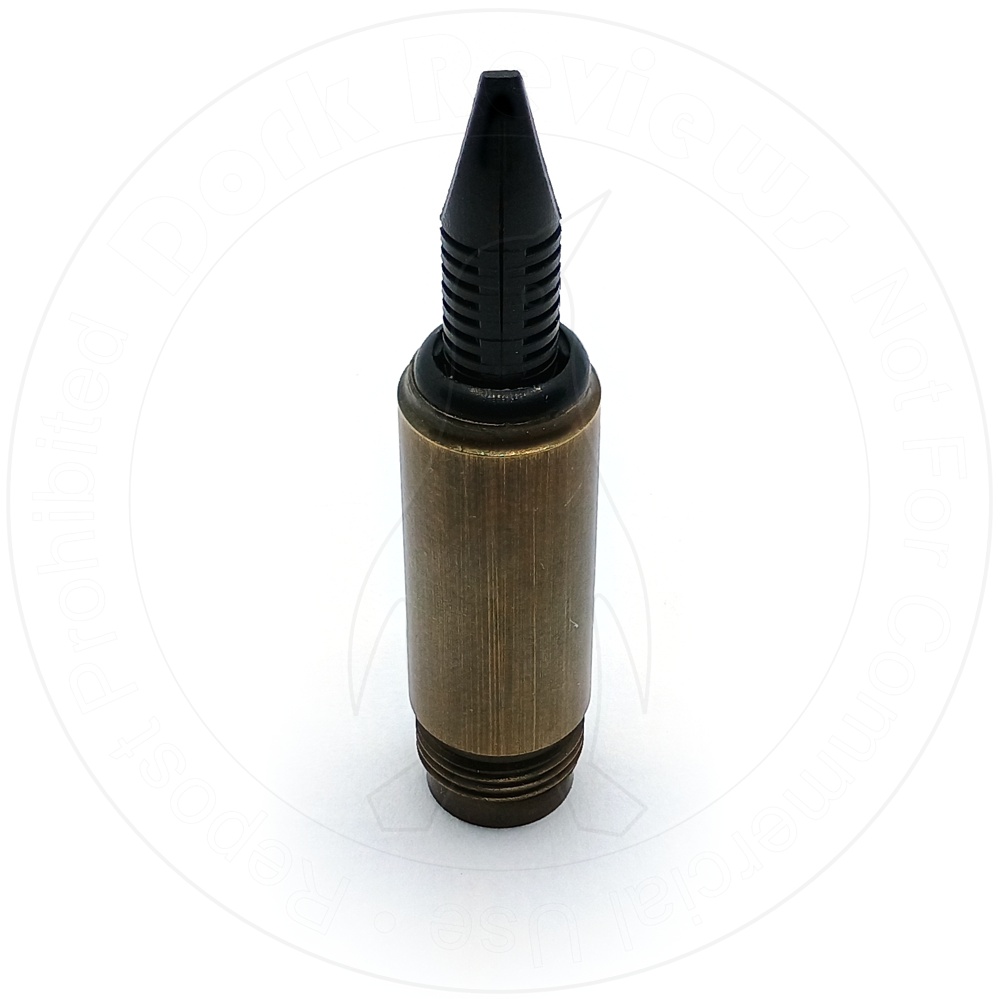
The feed indexes in via a slot on it that engages with a little fin on the section. It’s thus impossible to get wrong; you can only insert it one way.
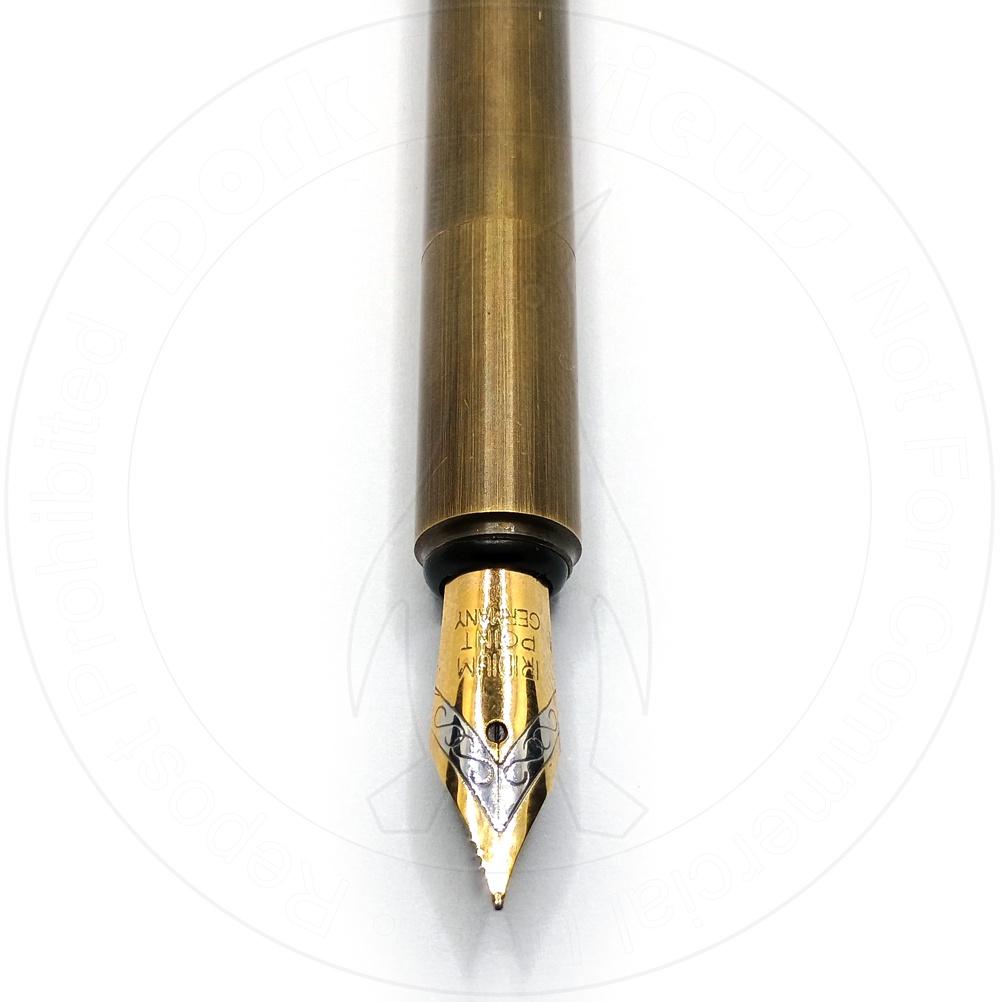
The nib is really nothing special. It’s steel, 0.40mm thick, and quite inflexible. It’s plated with something gold… colored, and has some scrollwork embellishments on it that do nothing.
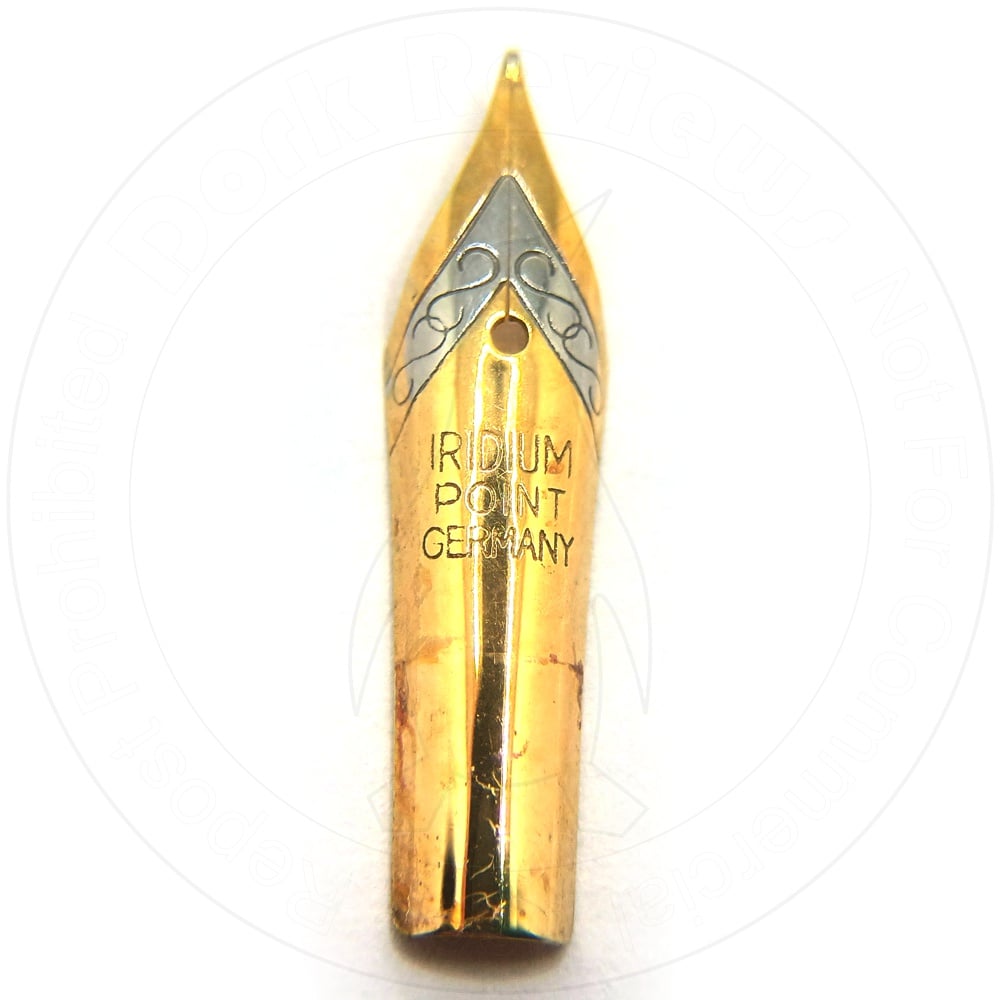
Given its dimensions I strongly suspect this is interchangeable with the garden variety #5 (i.e. 5mm) nibs which are only slightly less ubiquitous as their #6 counterparts. This raises the possibility that a suitably enthusiastic nut owner could swap it out with something a little more refined. A quality nib will probably run somewhere between 5 and 10 times the worth of this entire pen, so the financial wisdom of this endeavor is left as an exercise for the reader.
It says “iridium point” on it which is almost certainly a lie, and also “Germany” which definitely is.
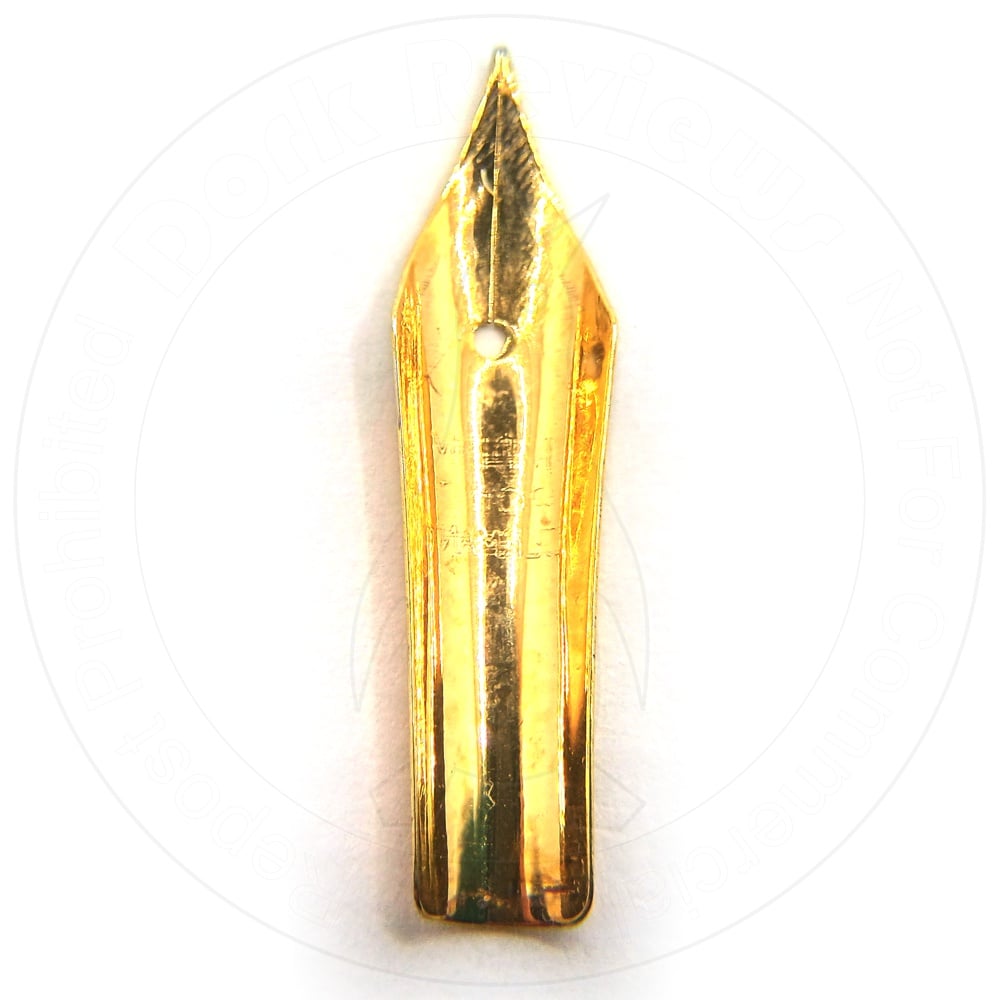
Flipping it over reveals that the markings are stamped into it and not engraved, which is not surprising given its cheapness but may just at the outside impact its performance, since the stampings carry clear through to the underside and will serve to separate it from the feed minutely.
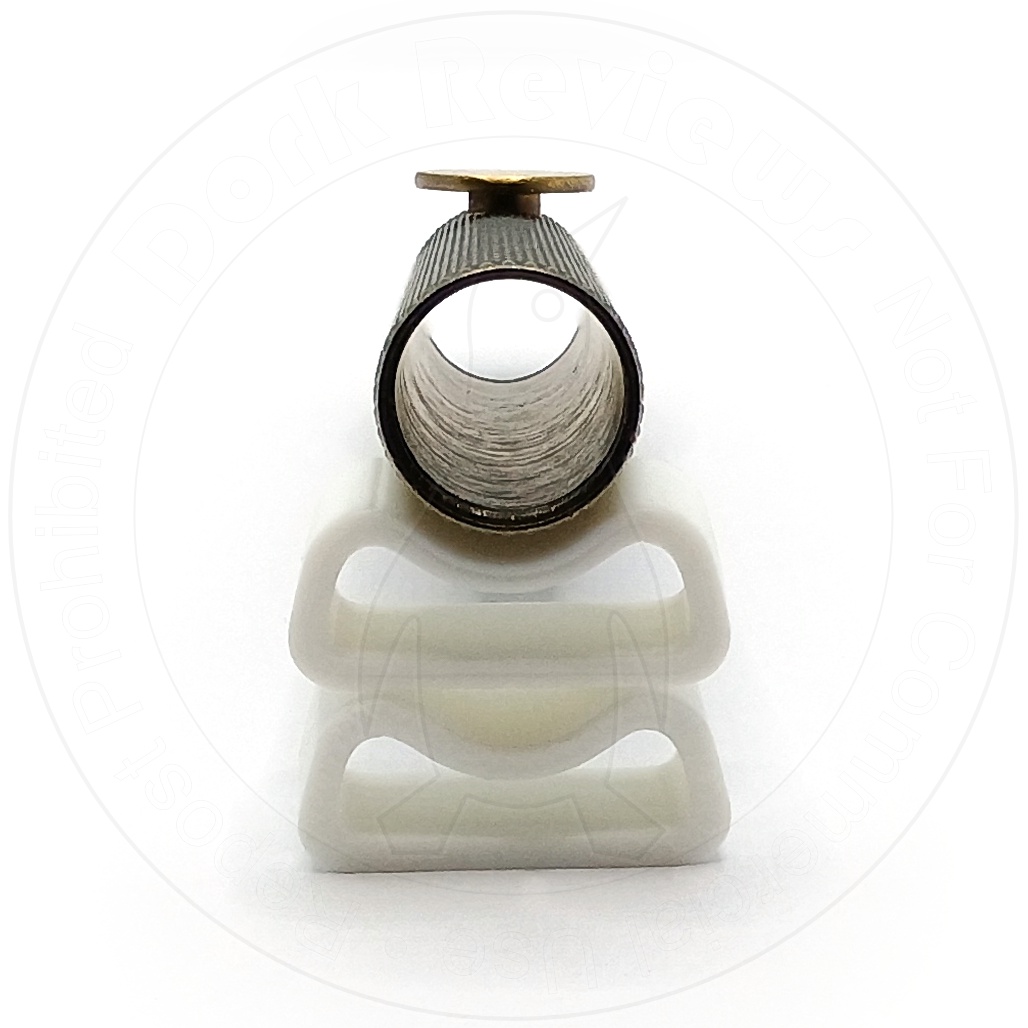
The body is a straight through tube with the same thread profile machined into both ends. You could thus assemble the pen backwards if you really wanted to. This also raises the possibility of spending $4 to get two of these, and you could assemble yourself a double header. Or install two tailcaps, an activity which would truly be – ah ha ha – pointless.
Writing With It
The Kawaii Desu writes like myriad other hyper budget Chinese pens. It’s not bad. It’s not special.
Of course, it will feel special – or at the very least quite different – to anyone who’s never handled a fountain pen before. Which these days is a surprising number of people. It seems in modern times the unordained automatically consider any fountain pen to be “fancy,” even when it decidedly isn’t.
Mine had a minor hard starting problem until I got the nib situated correctly on the feed. Now it works just fine. The seal of its end plug is only really okay, though. Mine will dry out noticeably if left unused for more than about three days, and thus far restarting it hasn’t been too hard but that might get annoying for someone who will use it only very occasionally. There’s nowhere to fit an O-ring or gasket in there, though, and all the contact surfaces are metal-on-metal. So maybe that’s to be expected.
Available nib options are fine, extra fine, and a “bent” (fude) option is also available. Super fine nibs kind of annoy me so I ordered the regular fine, though I suspect I was sent an extra fine anyway. That’s because the EF is rated at 0.38mm which is exactly the line with mine puts down, and the F is supposed to be 0.5. So I guess I got slightly ripped off. Oh well.
And the nib width is not marked anywhere on the thing, of course.
The extra fine nib is not as scratchy as you would expect and I actually rank it above such hyperbudget offerings as the Oaso K016. Not much line width variation is possible since the nib is stiff as a board, but with significant pressure you can achieve as much a 0.42mm. A whopping 10% difference! No one but the most maniacal of pen nerds would even notice.
I will use the customary writing example to illustrate the one big point about this that hasn’t been addressed:
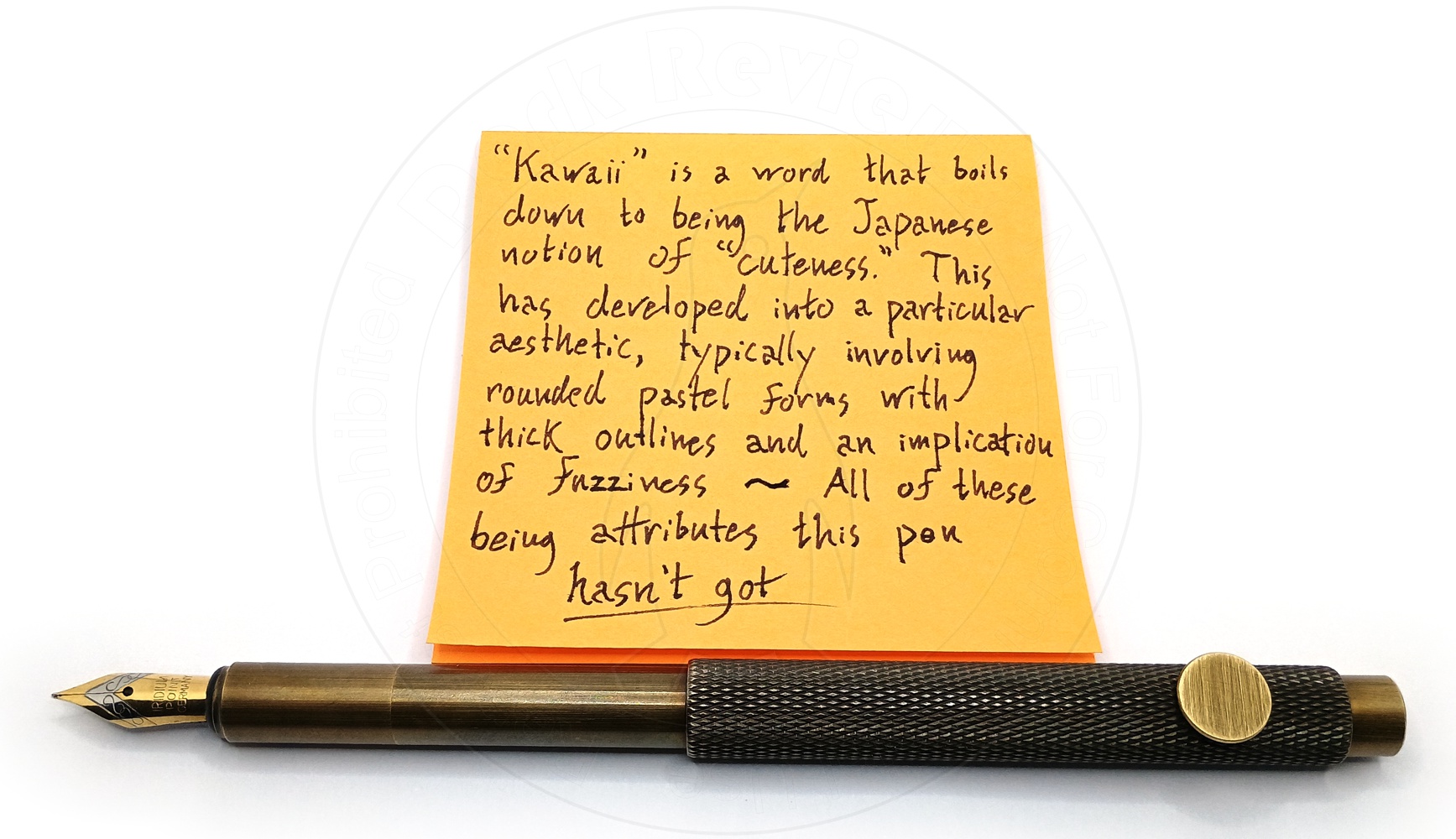
The Inevitable Conclusion
I have no damn idea why this pen is so frequently marketed as “kawaii.”
Because it isn’t.
Yes, it’s very small. But I would have been quicker to label it steampunk instead. (Which, yes, is about 80% of why I bought it. How did you know?)
Anyway, it’s amazing just how much pen you can get these days for less than what it would cost you to buy a 20 ounce soda at 7-11. This is a perfectly functional and reasonably well built fountain pen with quirky looks and a neat little form factor that’s so cheap you could truly treat it as disposable. And it’s not even made out of crappy plastic. That’s remarkable, right there.
It would be a bit better if getting it out weren’t such a faff. Unscrewing and re-screwing the halves together is probably fine if you’re going to be holding it for an extended period, but for duty as, say, a quick jotting short note taker I predict that’s going to wear out its welcome in a hurry.
The only other issue is that as ever there is no such thing as repeatability with these brandless products. It’d be one thing altogether if it had a model number, even a completely unmemorable and obtuse one. Even Jinhao pens have model numbers, but this doesn’t even manage that. I can’t in good conscience really recommend anywhere for you to get one nor what to ask for. You’ll just have to roll the dice and see what comes up.
That’s a really interesting and in-depth post. I think I’ll buy one!
That’s quite the post!
I’ll skimmed a bit I confess, but is it heavy?
I have a kaweko sport that is extremely light (which I like) but have a screw screw screw cap. Maybe I’ll splurge for this cheap one just because I haven’t bought a pen in a long time …
32 grams and some change. A little over three times the weight of a Kaweko Sport, but then the latter is made all of plastic.
If you don’t like unscrewing things this is unlikely to please you.
I think you are correct, and I will continue the search for the next pen elsewhere!
Wow cool pen. Great post.



